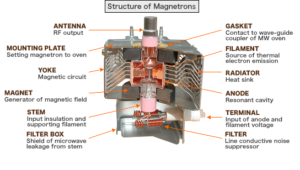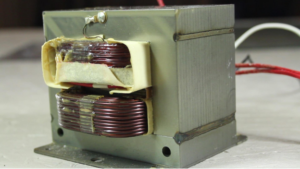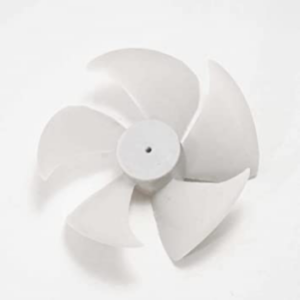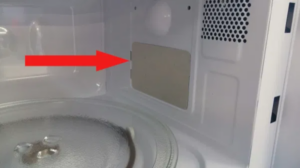Microwave Oven Technical Description
Anthony Del Rosario
City College of New York
ENGL 21007 – B2
Professor Sara Jacobson
April 13th, 2021
Table of Contents
- Introduction…………………………………………………..……………….3
- Overview of the components of a microwave……………………..4
- The Magnetron………………………….…………………..……………..…5
- Power Supply……………………………………………………..……….……6
- Cooling Fan……………………………………………..……………….……..7
- The Waveguide ………………………………..…………………………..…8
- Door and Door Safety Switch………..……………….…………………9
- Conclusion……………………………..…………………….………….……10
- Bibliography………………………………………..…………………….……11
- Self-Reflection………………………………..………………………..…….13
Microwave technical description
Figure 1

Note. From the Edison Tech Center, 2014
The microwave became widely available in the late 1960’s and early 1970’s. At the time, it was a fascinating new technology. It was first invented by Percy Spencer in 1947. (Brown, 2002) His discovery of using microwaves to heat up food was completely accidental. Spencer worked at the Raytheon Company, a company that manufactured magnetrons for radar systems. (Brown, 2002) According to the book “Inventing Modern America: From the Microwave to the Mouse” by David E. Brown, while testing a magnetron, he noticed the chocolate bar in his pocket melted, and he suspected that the magnetron was at fault. He predicted that the had microwaves melted the chocolate and not his own body heat. He proved his theory by repeating the scenario, but with a different type of food. He placed a bag of popcorn near the magnetron and when he turned on the magnetron, all of the kernels inside the bag started popping. After further research, Spencer published his discovery, received a patent for his invention and the Raytheon Company unveiled the world’s first microwave oven. (Brown, 2002)
The microwave oven is a very complicated kitchen appliance. As shown in Figure 1, the main components include the door safety switch, the wave stirrer, the oven cavity, the controls, the waveguide, the power supply, the magnetron and a cooling fan. (Edison Tech Center, 2014) Each of these components are essential for the microwave to work properly. According to Atif Qazi at KitchenGEaroid.com, the main heating element is the magnetron, which emits microwaves, and the cooling fan is keeps the temperature down. The waveguide keeps steam and other particles from damaging the electronic components. The controls allow you to instruct the microwave what you want it to do, and the power supply feeds the microwave (specifically the magnetron) with electricity. The wave stirrer allows the microwave to heat the contents evenly and lastly, the door safety switch will not allow the microwave to operate while the door is open. The door itself is also a safety feature as it keeps the microwaves in the oven. (Qazi, 2020)
Figure 2

Note: Diagram of a Magnetron, 2020
The first and most important component of the microwave is the magnetron. The microwaves produced by this machine can heat up the contents within the oven cavity. According to the FDA, “The microwaves are reflected within the metal interior of the oven where they are absorbed by food. Microwaves cause water molecules in food to vibrate, producing heat that cooks the food.” (FDA, 2017) The magnetron doesn’t actually produce any heat. Instead, the microwaves produce the heat within the food itself. Figure 2 shows the individual parts within the Magnetron that allow it to produce microwaves. (Edison Tech Center, 2014) Some of these parts include the Magnet, the Radiator, the Terminal, the Filament and the Yoke. (Magsells.co.uk, 2020)
Figure 3

Note: Step-up transformer picture from mad-science.wonderhowto.com, 2012
Another important component is the power supply. Without it, the microwave oven would not be able to operate at all. However, according to Qazi, most outlets are not capable of providing the amount of voltage a microwave requires. A microwave requires at least 4,000 volts to operate at full capacity, so microwaves are built with a step-up transformer within the power unit to significantly increase the voltage to the amount needed. (Qazi, 2020) Without this transformer, the microwave oven would be incapable to produce enough microwaves
Figure 4

Note: A cooling fan for a microwave oven, 2012
As with many electronic appliances and devices, the magnetron inside the microwave can get very hot while operating. To prevent any damage being caused due to heat damage, microwave ovens contain a fan that is conveniently placed next to the magnetron. This is shown in Figure 1. (Edison Tech Center, 2014) The production of microwaves is a very power consuming task and whenever a large amount of electricity is being consumed, heat is always a problem. The need for a cooling fan is amplified when you consider the fact that microwaves contain step-up transformers, which themselves get very hot, while producing large amounts of voltage, further heating up the magnetron. The food inside of the oven cavity is also heating up the microwave oven, so some form of cooling is required for this machine to continue working.
Figure 5

Note: Picture of the waveguide in a microwave oven, 2016
The waveguide is also crucial to the operation of the microwave oven. Its main purpose is to protect the electronic components that are just beside the oven cavity. As I stated earlier, the food begins to produce heat as the water molecules in the food vibrate due to the microwaves. (FDA, 2017) Steam also begins to exit the food as the water begins to boil, along with other food particles. If any of these particulates were to come in contact with any of the electronic components, there would certainly be damage caused. According to subzero-wolf.com, “The waveguide cover protects the gap where the microwaves enter the oven cavity from where they are produced by the magnetron. Additionally, it stops moisture and food particles from getting into the ‘workings’ of the microwave.” (Subzero-Wolf, n.d.)
Figure 6

Note: Photo of the metal mesh on the glass of a microwave oven door, n.d.
Figure 7

Note: The door safety switch of a microwave oven, 2012
The Door and the Door safety switch are both crucial safety features that are built into microwave ovens. The obvious function of the door is to close the oven and allow it to work, but it has a safety feature that frequently goes unnoticed. The glass on the door is not normal glass. It has a metal mesh imbedded in the glass that keeps the microwaves from escaping the oven cavity and potentially causing burns on someone. (Qazi, 2020) The door safety switch is also an important safety feature. The article “How to test a microwave’s door switch” states “A door switch is a simple on/off mechanism that prohibits the microwave from operating when the door is open.” (Parts Select, n.d.) It is a very simple, yet effective tool that keeps the user safe while operating a microwave oven.
So, in conclusion, the microwave oven uses a technology that was originally intended for radar systems, and it’s use for heating food was unintentionally and accidentally discovered. This technology, known as a magnetron, was used to create the microwave oven in 1947, and became more widespread and commonly used by the early 1970’s. It is a machine that produces microwaves which heat food from the inside. The microwave oven also utilized a transformer to meet the high voltage needs of a magnetron, a fan for cooling, a waveguide to protect the electronics, and safety systems in the door to protect the users from potentially harmful microwaves. All of these components combined create a safe and effective kitchen appliance for heating up all kinds of foods.
Bibliography
Brown, D. E. (2002). Percy Spencer: microwave oven (1947). In Inventing modern America: from the microwave to the mouse (pp. 80–83). MIT Press.
Qazi, A. (2020, February 20). How Does a Microwave Oven Work? – 7 Component Explained. Kitchen Gearoid. https://kitchengearoid.com/microwave-oven/how-does-a-microwave-oven-work/.
FDA. (2017, December 12). Microwave Oven Radiation. U.S. Food and Drug Administration. https://www.fda.gov/radiation-emitting-products/resources-you-radiation-emitting-products/microwave-oven-radiation
Waveguide Cover. Subzero-Wolf. (n.d.). https://www.subzero-wolf.com/assistance/answers/waveguide-cover-replacement
How to test a microwave’s door switch. Part Select. (n.d.). https://www.partselect.com/Microwave+test-door-switch+repair.htm.
Figure 1. (2014). Edisontechcenter.org. photograph. http://edisontechcenter.org/Microwave/MicrOvenDiagram700.jpg.
Figure 2. (2020). Magsells.co.uk. photograph.
https://www.magsells.co.uk/wp-content/uploads/2016/07/Inside-a-Magnetron-.png.
Figure 3. (2012). mad-science.wonderhowto.com. photograph.
https://img.wonderhowto.com/img/original/14/71/63490988605354/0/634909886053541471.jpg
Figure 4. (2012) Amazon.com. photograph.
https://www.amazon.com/LG-Electronics-Zenith-5900W1A007C-FAN/dp/B003DPNAM4
Figure 5. (2016) microwaveexpert.wordpress.com. photograph.
https://microwaveexpert.files.wordpress.com/2015/07/waveguide-cover-change-1.jpg
Figure 6. (n.d.) sciencephoto.com. photograph.
https://www.sciencephoto.com/media/74813/view
Figure 7. (2012) Amazon.com. photograph.
https://www.amazon.com/ERP-28QBP0495-Microwave-Door-Switch/dp/B002CRSOR0
Self-Reflection
When I started this project, I mainly had trouble deciding what object I was going to write a technical description on. At first, I was considering either an Electric Guitar, a TV, or a Microwave. I felt that the Guitar wouldn’t have enough components to talk about in a Technical Description. On the other hand, the TV might’ve had too many components to talk about and the Technical description could’ve surpassed 10 pages. However, once I did some research, I decided it was the best choice and had a good number of components. First, I looked up who invented the microwave oven. To do this, I went on the CCNY Libraries website and searched up the invention of the Microwave oven. I found a book that provided the history of many modern inventions, and one of these was the Microwave oven. This provided me with the content in my introduction. Next, I had to expand my research and find sources that described each component in detail. My main problem with this part was trying to find credible online sources and would actually help me prove my case. Some websites were credible but did not necessarily provide the information I was looking for. On the other hand, other websites provided exactly what I needed for my Technical Description, but the source was not credible and therefore I could not use it. I encountered this many times when going through websites trying to find specific information. I also encountered this problem when attempting to find pictures of the components of the Microwave oven. I found some great pictures online that I wanted to use, but these websites were also not credible, or I couldn’t cite them. I even found great pictures on blogs and forums, but of course I could use a blog or a forum as a source. Trying to find the direct source of the pictures I found also proved unsuccessful. I also do not have a microwave at the moment, so I had to completely rely on the internet. Thankfully, I did find pictures for most of the components and cited them properly. As for the content of the Technical Description, once I had found good sources I could trust, the rest was pretty straight forward. I simply divided each component into its own paragraph with a picture of the component before the paragraph. I read though the parts of the source that I needed and added the information to said paragraphs. I used both quotes and paraphrasing to include the information into my paper. My last step was to properly cite all of my sources. I used Perdue Owl for my citations, both for the book I used and the websites. For the photos, I manually created the citations in APA format. The format was Last name, Initials. (Year). Image title [Format]. Site Name. URL. I didn’t use the whole format however because almost all of the pictures provided no name, so I could only provide the website and date. Overall, I think I did pretty good on this Technical Description and I am satisfied with my work. I’m also glad I chose the microwave as I think it was a great choice for this paper. Putting most of my effort definitely helped a bunch and made the final draft easier to do. At first, I had some trouble choosing the object, starting my paper, and finding sufficient information from sources, but once I got started, I definitely got into it and it got much easier the more I wrote.

